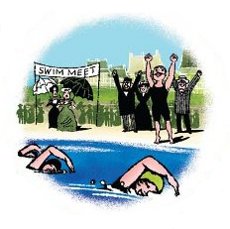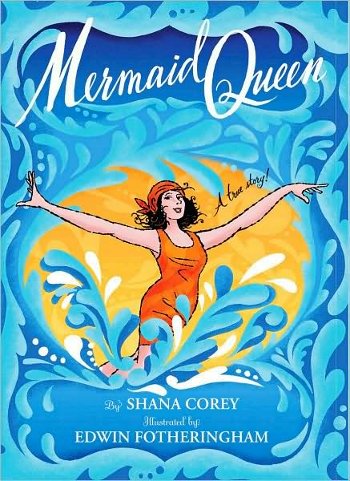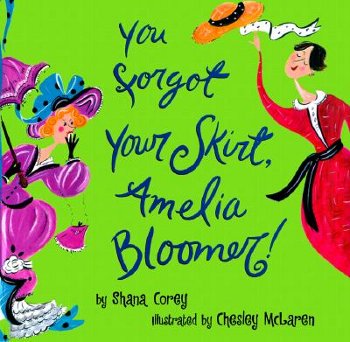The Mermaid Queen, Shana Corey, and
Some Art That’ll Really Wake You Up
 May 11th, 2009 by jules
May 11th, 2009 by jules
 Here’s swimmer, film star, fashion trend-setter, and the first woman to attempt to swim the English Channel, Annette Kellerman, “slicing through the water—winning races and setting records.” Have you all seen the fabulous new picture book biography about Kellerman and her derring-do? Perhaps you read Betsy Bird’s review of it last week. I love this book, and I’m here on this Nonfiction Monday to welcome the author, Shana Corey, who is going to talk a bit about the book and her work. Shana, as she writes in the book’s Author’s Note, has “always been interested in women and girls brave enough to make waves.” And I’ve got some fabulous art from the title to show as well — with fingers crossed that illustrator Edwin Fotheringham will soon be sending me his responses to my illustrator-interview questionnaire and then we can hear more from him, too. If you saw his work in last year’s What to Do About Alice?: How Alice Roosevelt Broke the Rules, Charmed the World, and Drove Her Father Teddy Crazy! by Barbara Kerley, then you know how exuberant Fotheringham’s highly stylized illustrations are. (If you’re like me and haven’t had your seven impossible cups of coffee before breakfast yet, Edwin’s art will wake up DIRECTLY.)
Here’s swimmer, film star, fashion trend-setter, and the first woman to attempt to swim the English Channel, Annette Kellerman, “slicing through the water—winning races and setting records.” Have you all seen the fabulous new picture book biography about Kellerman and her derring-do? Perhaps you read Betsy Bird’s review of it last week. I love this book, and I’m here on this Nonfiction Monday to welcome the author, Shana Corey, who is going to talk a bit about the book and her work. Shana, as she writes in the book’s Author’s Note, has “always been interested in women and girls brave enough to make waves.” And I’ve got some fabulous art from the title to show as well — with fingers crossed that illustrator Edwin Fotheringham will soon be sending me his responses to my illustrator-interview questionnaire and then we can hear more from him, too. If you saw his work in last year’s What to Do About Alice?: How Alice Roosevelt Broke the Rules, Charmed the World, and Drove Her Father Teddy Crazy! by Barbara Kerley, then you know how exuberant Fotheringham’s highly stylized illustrations are. (If you’re like me and haven’t had your seven impossible cups of coffee before breakfast yet, Edwin’s art will wake up DIRECTLY.)
 Corey’s Mermaid Queen (Scholastic, April 2009) is the story of Kellerman, born in 1886 in Sydney, Australia. Annette, as a child, had to wear leg braces (probably from rickets, Shana writes), but later she learned to swim and, as noted above, set many records. She began her swimming career at a time when women athletes were far from respected. But, believing swimming was the most superior sport, Annette kept at it and also spoke out against the constraining (to say the very least) ladies’ bathing costumes of that time. Once, when wearing a boy’s swimsuit at London’s Bath Club, she caused quite the stir and eventually sewed stockings onto the suit, a moment from her life included in Mermaid Queen — and done so dramatically and to great effect. Also included is the scene at Boston Harbor in the summer of 1908, which you can see here, in which Annette was arrested for indecency for not wearing a dress-and-pantaloon swimsuit, popular during that time.
Corey’s Mermaid Queen (Scholastic, April 2009) is the story of Kellerman, born in 1886 in Sydney, Australia. Annette, as a child, had to wear leg braces (probably from rickets, Shana writes), but later she learned to swim and, as noted above, set many records. She began her swimming career at a time when women athletes were far from respected. But, believing swimming was the most superior sport, Annette kept at it and also spoke out against the constraining (to say the very least) ladies’ bathing costumes of that time. Once, when wearing a boy’s swimsuit at London’s Bath Club, she caused quite the stir and eventually sewed stockings onto the suit, a moment from her life included in Mermaid Queen — and done so dramatically and to great effect. Also included is the scene at Boston Harbor in the summer of 1908, which you can see here, in which Annette was arrested for indecency for not wearing a dress-and-pantaloon swimsuit, popular during that time.


I won’t give away any more from the title so that you can read and experience it yourself, this spirited biography of the woman who pioneered the modern woman’s swimsuit and the person often credited for inventing the sport of synchronised swimming — and who went on to become a vaudeville and film star. (Esther Williams played Kellerman in 1952’s Million Dollar Mermaid.) Corey humanizes the larger-than-life Kellerman by bringing to vivid life details of her upbringing and personality; Kirkus praised Corey for her “lively descriptions and powerful phrasing.” And, as for the art, I hope to goodness that Edwin Fotheringham keeps illustrating children’s books. (What to Do About Alice? was his debut in children’s books, though he’s done a lot of editorial and advertising illustration work and graphic design work).
Here is Shana—who is going to have a cyber-croissant with me, as well as some pipin’ hot, strong coffee—in her own words. I thank her for stopping by.
 “I come to writing from a few different angles — I’m a reader, I’m the mom of two little boys (we have a lot of books about trains and trucks in our house), and I’m also an editor of kids’ books. When I first started editing, I was primarily editing early readers, and they were a great training ground for picture books. They teach you to have action on every page. (Dialogue is tough to illustrate.) They also teach you to be frugal with words, and that stayed with me when I started to write picture books. Picture books are meant to be read aloud, and—as a mom—I know I blanch a bit when I see dense text in a picture book, and so in my own books I get nervous when I see more than a paragraph or so on a page, and my favorite spreads are definitely those with the fewest words.
“I come to writing from a few different angles — I’m a reader, I’m the mom of two little boys (we have a lot of books about trains and trucks in our house), and I’m also an editor of kids’ books. When I first started editing, I was primarily editing early readers, and they were a great training ground for picture books. They teach you to have action on every page. (Dialogue is tough to illustrate.) They also teach you to be frugal with words, and that stayed with me when I started to write picture books. Picture books are meant to be read aloud, and—as a mom—I know I blanch a bit when I see dense text in a picture book, and so in my own books I get nervous when I see more than a paragraph or so on a page, and my favorite spreads are definitely those with the fewest words.
As a reader, I’ve always had a thing for olden-day girls. Growing up, I loved Little House on the Prairie, Betsy-Tacy, A Little Princess, All-of-a-Kind Family. As I got older, that morphed into an interest in women’s history (the grown-up word for olden-girls), which is what most of my books are about. I tend to be drawn to stories about real-life rebels in history—people who defy convention and expectations—largely because, as much as I wish that were me, I’m more of a follower myself, and so that’s something I really admire.
 Mermaid Queen is a story about one of those real-life rebels — Annette Kellerman. I initially came across Annette’s name when I was researching my first book, You Forgot Your Skirt, Amelia Bloomer! It struck me that, despite being born on different continents almost seventy years apart, Annette and Amelia had a lot in common. Both resisted the accepted paths available to proper ladies of their day, and both were rebels who weren’t afraid to buck convention when convention didn’t make sense. For them, that meant challenging the dress norms of the day. (As someone who spent much of high school wearing pegged jeans, I can attest to how brave that is.)
Mermaid Queen is a story about one of those real-life rebels — Annette Kellerman. I initially came across Annette’s name when I was researching my first book, You Forgot Your Skirt, Amelia Bloomer! It struck me that, despite being born on different continents almost seventy years apart, Annette and Amelia had a lot in common. Both resisted the accepted paths available to proper ladies of their day, and both were rebels who weren’t afraid to buck convention when convention didn’t make sense. For them, that meant challenging the dress norms of the day. (As someone who spent much of high school wearing pegged jeans, I can attest to how brave that is.)
One of the words that was most often used to describe Annette in newspapers of her day is “pluck.” It’s one of my favorite words (along with “moxie” and “gumption,” which Annette also had). To me “pluck” is a combination of courage and confidence — courage to try things others might not approve of and confidence to keep trying, no matter what anyone else says. That’s something I write about, because it’s something I aspire to.

and the more she swam, the stronger she grew.”

Because there hasn’t been much written about Annette, Annette was the most intensive, exciting, and—at times—frustrating research I’ve ever experienced. I read a lot of Annette’s own writing, which was wonderfully fun. (She’s something of a card.) I also spent a lot of time squinting over old microfilm in the library, saying “aha!” and pretending to be one of the characters in the book Possession.
Instead of telling complete biographies, I also like to focus in on smaller stories — the moments of change in history that helped get us from there to here. Those moments are exciting to me, because they remind me that history isn’t a separate, constant thing. It’s a continuing story that we’re all a part of. And the world isn’t usually changed by far-away battles or famous people. More often, it’s a series of small changes, small steps taken by regular people that end up turning the tide of history. That inspires me, because if these individual people can change the world, then we can, too.“


Thanks again to Shana for stopping by. If you’re interested in reading about more nonfiction titles today, head on over to the Nonfiction Monday round-up at Book Scoops.
Illustrations from Mermaid Queen: The Spectacular True Story of Annette Kellerman, Who Swam Her Way to Fame, Fortune, & Swimsuit History copyright 2009 by Edwin Fotheringham. Used with permission from Scholastic Press.

I reviewed Shana’s book last week (along with Dan Yaccarino’s book on Jacques Cousteau), and am totally in love with it. And now with her – I love that she pretended to be one of the characters in POSSESSION, because that’s just the sort of way I feel sometimes doing Jane research – particularly when field trips are required!
Thanks so much for posting this!
Congrats Shana! The book looks wonderful. Can’t wait to get a copy. Let us know if you’ll be doing any book events.
“Olden-day girls” – what a perfect description of the characters I have also always been drawn to, especially in children’s books. I have a collection of the Betsy-Tacy books mentioned by Shana – I ate them up as a young girl, and have read them over and over and over again (and I belong to the national fan club). Now I know why I was immediately taken by this author and Fotheringham’s old-fashioned illustrations. I’ll have to get a copy. Wonderful way to start out the week, Jules!
What fun! Had never heard of Annette Kellerman. Looks like Shana and Fotheringham did a fabulous job of telling her story.
Thanks all and thank you so much Jules for having me! Sean-I’ll be signing at ALA and would love to see you guys there!
[…] will be about the new picture book biography of Juliette “Daisy” Gordon Low, written by Shana Corey with artwork from debut illustrator Hadley Hooper. Low was the founder of the Girl Scouts, and I […]
[…] week, I weighed in on Shana Corey’s picture book biography, Here Come the Girl Scouts!, illustrated by debut artist Hadley Hooper. That […]
[…] first admired Shana Corey‘s work in MERMAID QUEEN; what a delightful book as discussed at Seven Impossible Things Before Breakfast with a captivating interview of Shana at Cynsations. You will also find an informative […]
[…] Chris: The Secret Subway, written by Shana Corey, which is a picture book that has just entered the sketching […]